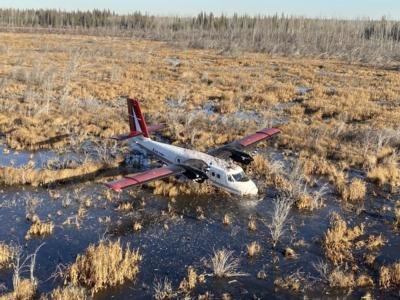Another Incident, Another Lesson in Checklist Adherence
Canada's Transportation Safety Board has published a safety investigation report regarding a 2021 incident involving an Air Tindi Twin Otter that went down due to fuel starvation.

The de Havilland DHC-6-300, C-GNPS, left Yellowknife Airport in the Northwest Territories on a VFR flight to Fort Simpson Airport. The flight carried 2 pilots and 3 passengers. The flight proceeded as normal until crews noticed an insufficient fuel state to complete the planned flight. Worse, they realized that 40 minutes of flight had put them outside range of Yellowknife, resulting in a diversion to Fort Providence Aerodrome. While en route, the crew informed the Air Tindi of their plans and shut down the left engine in an effort to limit fuel consumption. In classic Murphian form, the right engine soon flamed out.
The crew completed a forced landing onto Muskeg, with an ELT signal successfully transmitted to the Canadian Mission Control Centre shortly after. The landing was made late in the evening around 1900 hrs about 7 nm northwest of their planned airfield, exposing passengers to the elements until recovery by authorities. The Twin Otter is said to have sustained "substantial damage."
The cause of the incident comes down to a procedural issue and a breakdown of communication. The investigation showed that Air Tindi personnel usually informed flight coordinators of how much fuel was required for their next flight, which was then petitioned from personnel at the field. For the incident flight, investigators could not find whether or not the flight crew had requested fuel from the coordinator, while a fuel order was not placed, too. Like any accident chain, the clues add up in retrospect - The busy crew continued as per the usual routine, while the caption incorrectly assumed a fuel receipt sticking out of the map pocket indicated a fresh load of 2,500 lbs of fuel. The crew remained occupied with starting the aircraft until passengers boarded, when the captain interrupted his flow to speak with a former Air Tindi employee coming aboard. With his rhythm broken, the captain completed a series of checklist items from memory, with everything from After Start to Cruise completed without
referencing paper checklists.
The Board notes that at this point in the incident, a disciplined crew (which we all are...in theory) should have checked the Otter's fuel quantity at least 3 times. Around this time, as the aircraft flew at a cruise altitude of 6,500 ft, the fuel company inquired as to whether or not the outbound flight required a fuel-up only to be told the plane was already en route. At that time the low-fuel caution light illuminated, with approximately 60 gallons of fuel on board. The plane had only 40 minutes of flight time remaining, even with all 17 gallons of aux fuel counted. After attempting to divert and conserve fuel, the crew was forced to pitch for best glide and set the plane down in a non-wooded, marshy location in the Muskeg. The aircraft remained upright throughout the landing, with all aboard waiting 4 hours for rescue to pick them up. Thankfully, aside from minor hypothermia ailed those involved in the incident.
Overall, the report portrays a cautionary tale for pilots, warning against ever-present complacency. Like so many pieces involving a fuel starvation issue, the ingredient list is familiar: Pilots with somewhere to be, an unspoken assumption of tasks completed, insufficient adherence to checklist items, and lackadaisical cockpit procedures. All are unfortunately common items on flight decks every day of the year, making this event another sobering reminder to maintain discipline, communicate, and use the checklist - even though sometimes that's easier said than done.
 Sierra Space Repositions Dream Chaser for First Mission
Sierra Space Repositions Dream Chaser for First Mission ANN's Daily Aero-Term (05.10.24): Takeoff Roll
ANN's Daily Aero-Term (05.10.24): Takeoff Roll Aero-News: Quote of the Day (05.10.24)
Aero-News: Quote of the Day (05.10.24) Aero-News: Quote of the Day (05.11.24)
Aero-News: Quote of the Day (05.11.24) ANN's Daily Aero-Term (05.11.24): IDENT Feature
ANN's Daily Aero-Term (05.11.24): IDENT Feature



